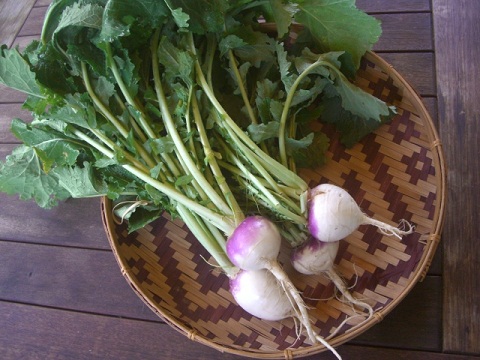Ask a random passerby when was the last time he or she had turnips, and you're likely to get one of the following responses: "Hmm-mm -- 1973?" or "Not since my mother made me eat them when I was six" or -- the most likely -- "Huh?"
The turnip has largely fallen into oblivion these days, especially in North America, but once upon a time it was a valued root crop for much of the civilized world. The Greeks and Romans, well back into the BC centuries, prized them highly; Pliny the Elder sang the praises of the turnip, opining that "its utility surpasses that of any other plant", and Sappho classically referred to one of her sultry paramours with the affectionate nickname "turnip" (in Ancient Greek, of course). Before the ubiquitous potato, the turnip was a staple crop for numerous civilizations. Now, alas, it has been consigned to the margins of various ethnic cuisines.
And that's a shame, because not only are turnips quite delicious when properly prepared, but as a member of the cruciferous family of vegetables, they are also very good for you. And don't neglect to eat the green tops as well, for they too are an excellent source of nutrients.
So it's time to add turnips and their greens to your arsenal of beneficial veggies. Your local health food store or farmers market will likely provide you with the freshest and sweetest turnips to be found. The roots should be smooth and unblemished, the greens should be crisp and dark green. Cut off the greens and store them separately; the roots will keep for several weeks in the fridge, the greens should be used within a few days for maximum nutritional benefit.
Wherefore Art Thou Rutabaga?
When I was a kid, there was almost always a waxy, orange-shading-to-purple small bowling ball of a vegetable in the root basket in my Irish Mom's pantry. She called it a turnip, and so for many years I did too. But it was actually a rutabaga -- thought to be a cross between a wild turnip and cabbage -- and she used to combine it with mashed potatoes for a most toothsome Gaelic dish.
They're somewhat more difficult to locate these days and may be identified as a "Swede" (their nomenclature in much of the world outside North America) or "neep" (by the Scots), but they are well worth the effort to seek them out. Sweeter and tenderer than turnips, they are rich in beta-carotene and packed with Vitamin A.
Asian-Style Braised Baby Turnips
This simple dish is perfect with teriyaki ahi or chicken...
- 3 lbs. small white turnips w/ tops
- 3 tablespoons white miso
- 1 1/4 cups water
- 2 tablespoons sake
- 1/2 teaspoon minced fresh lemongrass
- 1 teaspoon toasted sesame oil
- 1 tablespoon chopped fresh cilantro leaves
- Trim turnips and cut in half; discard stems, chop greens and set aside.
- In a medium saucepan, combine turnips, miso, water, sake & lemongrass. Bring to a boil, reduce heat and simmer until just tender, about 10-15 minutes. Add greens, return to a boil, and cook uncovered until liquid is reduced to a glaze, about 5 minutes. Transfer to warm serving dish; drizzle with sesame oil and sprinkle with cilantro.
Serves four as a side dish.
Smashed Rutabagas & Yukon Gold Potatoes
This hearty offering pairs beautifully with a nice slow-cooked pot roast on a wet chilly winter's day...
- 2 lbs. rutabagas, peeled & cut into 2-inch pieces
- 2 lbs. Yukon Gold potatoes (or other yellow-type potato)
- 1/3 cup extra virgin olive oil
- 3 tablespoons organic butter
- 2 tablespoons horseradish
- 2 tablespoons snipped fresh chives
- In a large pot, cook potatoes in water to cover until soft, about 25 to 30 minutes; drain, then return to heat and dry a bit for about one minute, shaking pot. Transfer to large warm bowl.
- At the same time, in another large pot cook rutabagas in water to cover until tender, about 15 to 20 minutes; drain, then return to heat and dry a bit for about one minute, shaking pot. Transfer to bowl with potatoes.
- Lightly smash the potatoes and rutabagas with a masher; add olive oil & butter and smash a little more. Stir in horseradish and chives, and salt and pepper to taste.
Serves six to eight as a side dish.
[Note: A version of this post appears in my column "Eat Smart" in the March issue of Better Nutrition Magazine.]

